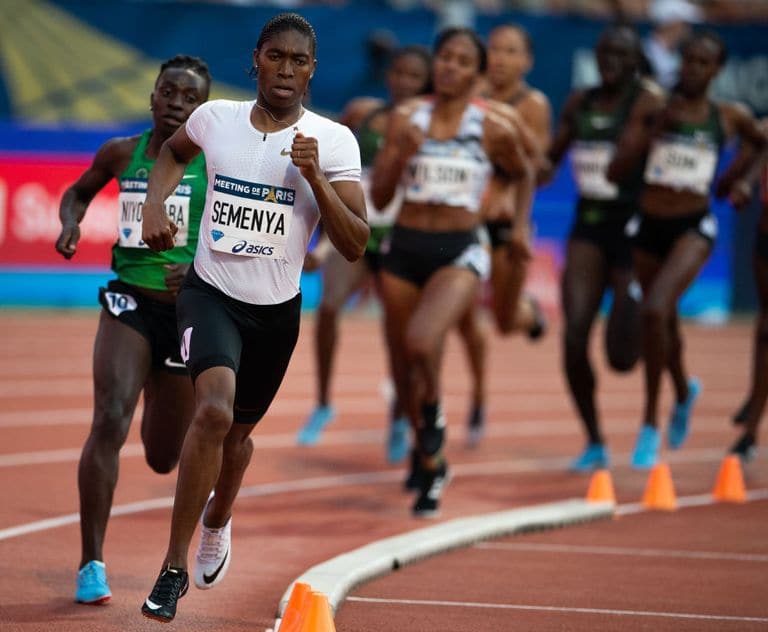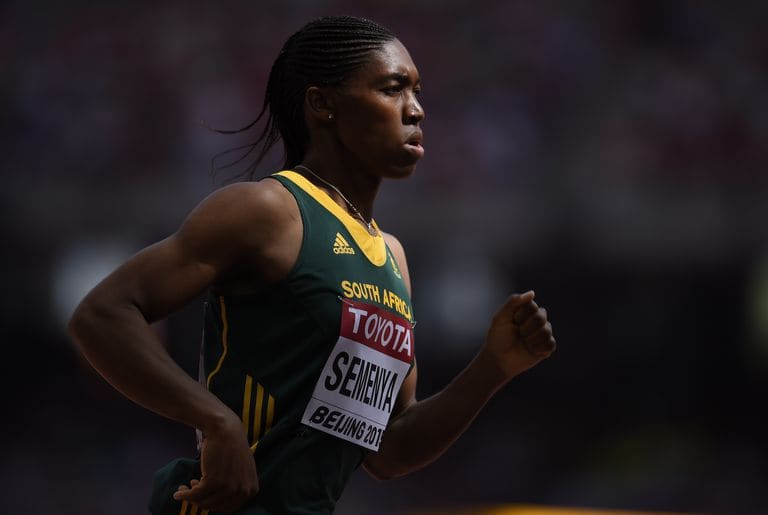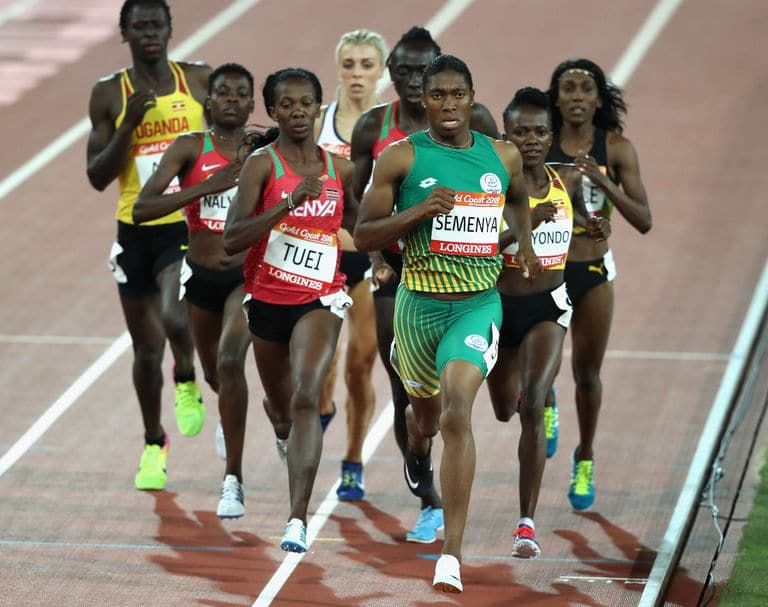Caster Semenya’s Pro Eligibility Is Still In Question. Here’s Why That’s Total Bullshit
why hasn’t the rule been thrown out?
South African middle distance runner Caster Semenya could miss the entire 2019 season because track and field’s governing body won’t drop a decade-long effort to lower her testosterone. Their argument that her naturally-occurring levels are unfair to female competitors is based on a single, flawed study, and the outcome of a (recently expedited) international court case that could uphold a limit on women’s testosterone would have lasting implications. The conventional wisdom is based on the assumption that Semenya’s hyperandrogenism gives her an unfair advantage. An examination of the process by which that wisdom was established reveals something more sinister than negligence: a calculated, long-term effort to ban an athlete whose presence on the track makes people uncomfortable.
On Tuesday, the International Association of Athletics Federations (IAAF) announced it would delay the implementation of eligibility requirements for female classification in exchange for an expedited Court of Arbitration for Sport (CAS) case against Semenya. The South African is challenging an April regulation that would effectively force her to take testosterone suppressants to compete in international athletics. The IAAF has pushed back the previous November 1 deadline for athletes to begin testosterone suppression treatment (designed to allow time for testosterone levels to decrease ahead of the 2019 World Championships) by five months while the case is decided, according to an IAAF press release on the apparent agreement between the two parties.

Caster Semenya ran a lifetime PR of 1:54.25 at a June 2018 IAAF Diamond League meet in Paris. In April, the IAAF established a regulation that would ban Semenya at her current natural testosterone levels.
Andy Astfalck Getty Images
The IAAF began questioning Semenya’s participation in 2009 after she won the 800-meter World Championship in 1:55.45, 2.17 seconds off the world record. The current regulation requiring female testosterone suppression comes from a single IAAF-funded study that indicates hyperandrogenic women like Semenya enjoy a significant (3 percent in the 800 meters) advantage over competitors. The study’s data is flawed—its coauthor said so following an independent review—but that hasn’t deterred the IAAF.
Elite sport rewards physiological advantages: British marathon champion Paula Radcliffe’s VO2 max at age 17 was 70 ml/kg/min, according to a sport scientist who regularly tested Radcliffe’s fitness. Such a high aerobic capacity is abnormal, yet Radcliffe’s right to compete was never questioned because of it (Radcliffe is among the current and former elite athletes who have spoken out against Semenya’s participation).
However, Tuesday’s development is the latest in a long history of women’s sex being questioned in athletics. To understand Semenya’s current predicament, you have to understand what happened to Dutee Chand.
Chand is an Indian sprinter who won bronze at the 2013 Asian Athletics Championships. She qualified for the 2014 Commonwealth Games, but India’s governing body deemed her ineligible for competition because of her hyperandrogenism. The question of Chand’s sex caused public humiliation, the Hindustan Times reports. “When I lose, they’ll say Dutee has grown old,” Chand told the Times earlier this year. “When I win a medal, they think it’s hyperandrogenism.” Though a standout in India, Chand’s 100-meter PR is 0.75 seconds slower than the world record.

South Africa’s Caster Semenya celebrates after winning the women’s 800m final race of the 2009 IAAF Athletics World Championships on August 19, 2009 in Berlin. The standout performance caused critics to question her legitimacy as a female competitor.
OLIVIER MORIN Getty Images
The IAAF upheld Chand’s suspension, citing a 2011 regulation that banned women with testosterone levels higher than 10 nanomoles per liter (the IAAF claims normal male testosterone ranges between 7.7 and 29.5 nmol/L; the normal range for women is 0.12 to 1.79 nmol/L). That ruling came after the IAAF temporarily banned Semenya in 2009 when competitors questioned her sex; the organization reversed the ban in 2010, following a year of medical tests and public speculation on Semenya’s sex.
“The sport wasn’t very welcoming to women who deviated from how we expect women to present themselves, especially in running events,” says Madeleine Pape, a sociology Ph.D. candidate at University of Wisconsin-Madison and former Australian 800-metre runner who competed against Semenya during the initial controversy. Pape recalls seeing Semenya during warm-ups and thinking the South African “presented like a tomboy,” but Pape was more intimidated by Janeth Jepkosgei, the slender defending world champion from Kenya.
Whether Semenya underwent any testosterone suppression to meet the 10 nmol/L threshold is unknown, but in 2015, Chand appealed her IAAF-sanctioned ban to the CAS, the highest court in international sport. That’s when the IAAF produced a study, years in the making, that analysed performance data from the 2011 and 2013 IAAF World Championships and concluded that women with hyperandrogenism enjoy an advantage over women with average testosterone levels.
Chand’s pro-bono legal team had just three months to disprove the results of the study, which the IAAF funded and took years to produce. Yet the CAS still sided with Chand. The data didn’t show a significant enough advantage, the court concluded. But the 10 nmol/L regulation wasn’t thrown out; rather, it was suspended until the IAAF could produce research that proved a “quantitative relationship between enhanced testosterone levels and improved athletic performance in hyperandrogenic athletes.” If the IAAF couldn’t provide the research in two years time, the hyperandrogenism regulation would be void.
Last year, just before the two-year deadline, IAAF-funded researchers published a study in the British Journal of Sports Medicine that used the same dataset to conclude that hyperandrogenic women have a 3 percent advantage in the 800-metre run (it also cited advantages in the 400-meter run, the 400-metre hurdles, the hammer throw, and the pole vault). In April 2018, the IAAF announced it would not only reinstate the hyperandrogenism regulation, but that it would be lowered from 10 nmol/L to 5 nmol/L, based on the findings of the 2017 research. Curiously, the regulation wouldn’t affect the hammer throw and pole vault, but it would affect the 1500-metre and 1.5km runs—events where no significant advantage was found. Semenya’s team announced it would challenge the regulation in the CAS, questioning the same dataset that Chand’s legal team did in 2015.

Caster Semenya competes at the IAAF World Championships in 2015, the same year Dutee Chand upended an IAAF regulation that barred Chand from international athletics.
OLIVIER MORIN Getty Images
Here’s where ethics and science intersect: Critics say IAAF researchers Stéphane Bermon and Pierre-Yves Garnier (who was sanctioned for interfering with an IAAF ethics investigation last year) essentially re-ran the statistical analyses on the same data until they produced a different conclusion. But three independent researchers—Roger Pielke of the University of Colorado-Boulder, Ross Tucker of the University of Cape Town, and Erik Boye of Oslo University Hospital—couldn’t reproduce Bermon’s and Garnier’s analyses with publicly available data, so they called on the researchers to release the 2011 and 2013 performance data.
When Bermon and Garnier released a partial dataset, the independent researchers found glaring errors: Athletes and times had been wrongly duplicated, and some times weren’t accounted for whatsoever. Those mistakes accounted for between 17 and 33 percent of the data used to justify the 5 nmol/L threshold in the middle distance events, and when pressed, Bermon herself confirmed the errors. And crucially, to find the edge women with hyperandrogenism allegedly have, the researchers used data from women whose testosterone was elevated because of hyperandrogenism, but they also included results from deliberate dopers and athletes with therapeutic use exemptions (TUE’s).
Yet Bermon stands by the results of the study, as does the sport’s governing body. “The IAAF remains very confident of the legal, scientific, and ethical bases for the regulations,” Tuesday’s press release reads.
To review: An international court upended an IAAF regulation that prevented women with testosterone levels higher than 10 nmol/L from competing because the research didn’t support a significant hyperandrogenic advantage. In response, the IAAF massaged the data, reinstated the regulation, and lowered it to 5 nmol/L to prevent even more hyperandrogenic athletes (read: Semenya) from competing. Now they know the data is bad, and they’re still pushing to ban Semenya unless she deliberately and fundamentally alters her body with hormone therapy. Even for the IAAF, an organization with a history of corruption and deceit, this is a new low.
Pape testified in Chand’s case against the IAAF, stating that elite athletes hadn’t reached a consensus on Semenya’s competition status. “It should be that we’re supporting an objective scientific process where we allow debate,” she says, although the reality is different. “The policy is driving the research instead of the research driving the policy.”

Caster Semenya leads the pack in the Women’s 800-meter final on day nine of the Gold Coast 2018 Commonwealth Games at Carrara Stadium on the Gold Coast, Australia.
Jason O’Brien Getty Images
The history of sex-testing female athletes is disturbing—it’s included mandatory genital checks, as Semenya had in 2009—and testosterone is merely the latest in a line of verification methodologies that have been enacted before they’re fully understood. Thirty years after the IAAF and the International Olympic Committee began using chromosome tests, the IOC released data on eight women at the 1996 Atlanta Games who had Y chromosomes. Of the eight, seven were androgen insensitive, meaning their bodies were resistant to male sex hormones and the women therefore gained no advantage, the New York Times reported.
If the CAS sides with the IAAF, Semenya will miss the entire 2019 competition season. After that, she’ll have to alter her body to continue competing internationally. She doesn’t have the world record. Her hyperandrogenic physicality hasn’t made her the best ever. Michael Phelps, whose long limbs and uncommon flexibility contributed to his dominance, was never questioned for his natural advantage.
Semenya’s case invites much larger questions about the role of intersex athletes in athletics, questions that Pape says aren’t going away no matter the CAS verdict. Pape recently presented at an athletics conference in Botswana, where Semenya was present. “She was like a rockstar. The reaction you see people have to Usain Bolt—it’s the same reaction, but to Caster Semenya.” Bolt’s physical anomalies won him hero status in the West, just as Semenya’s have in sub-Saharan Africa, Pape says. However, asked whether Semenya will get the chance to finish on top, like Bolt, Pape is uncertain. “Having [seen the crowd’s reaction in] Botswana and South Africa, I’ve seen what could have been, hopefully what could still be,” she says. “I guess I’m not feeling overly optimistic.”
READ MORE ON: caster-semenya hyperandrogenism news

